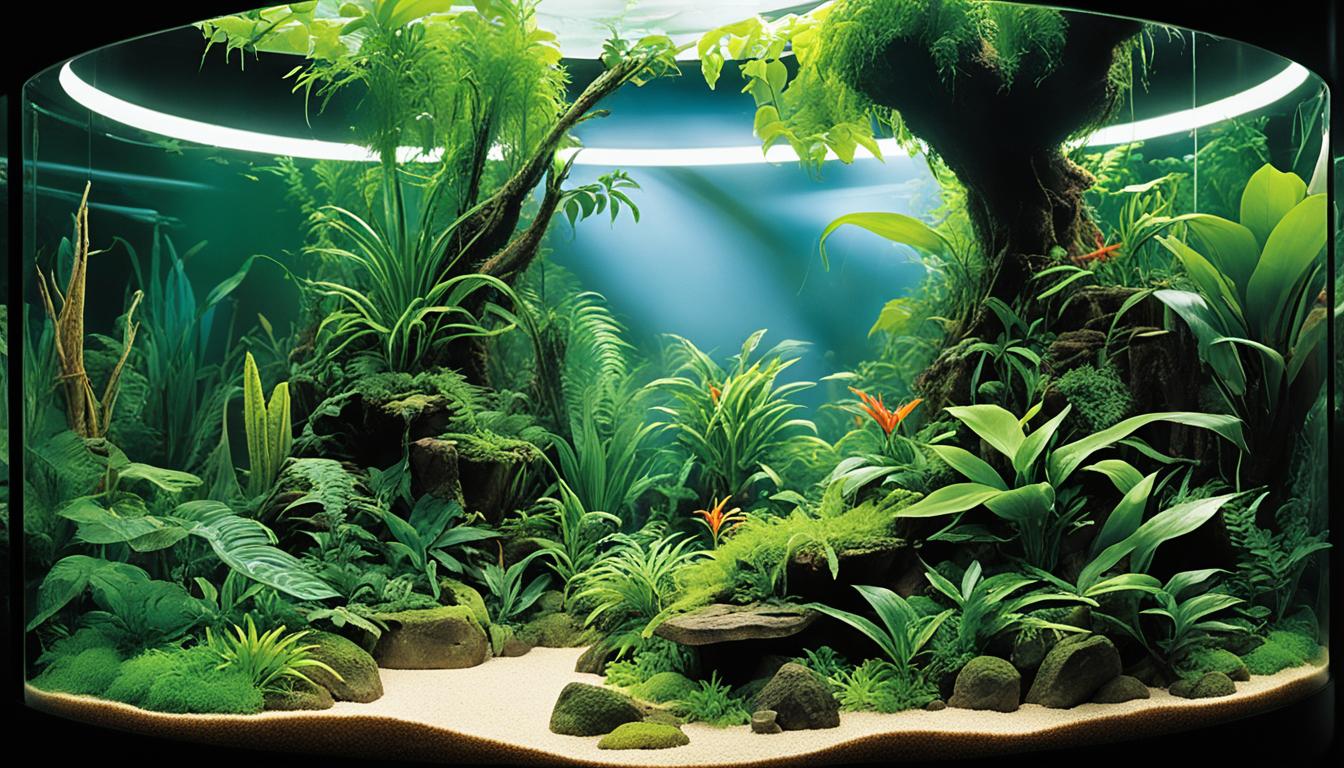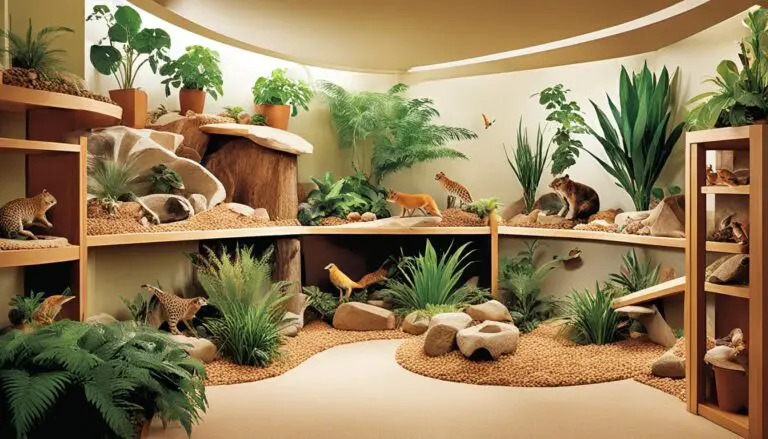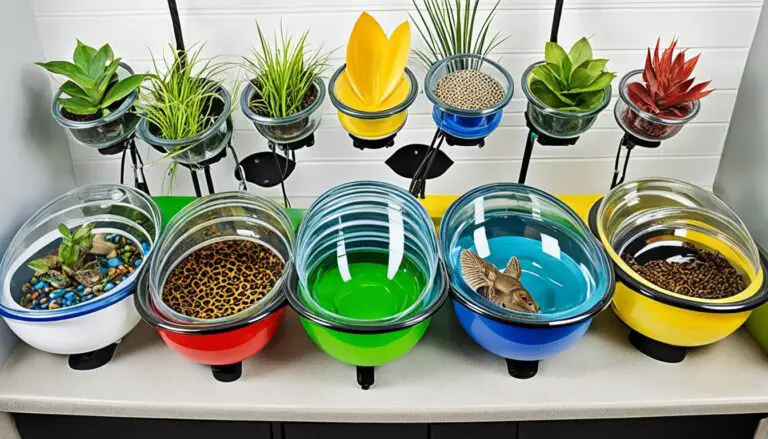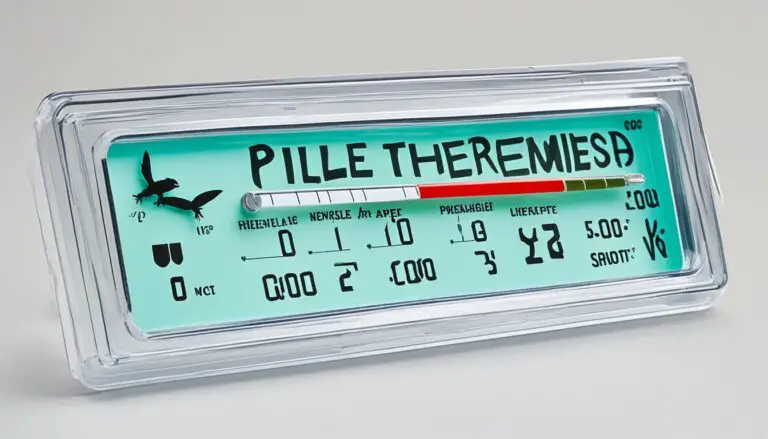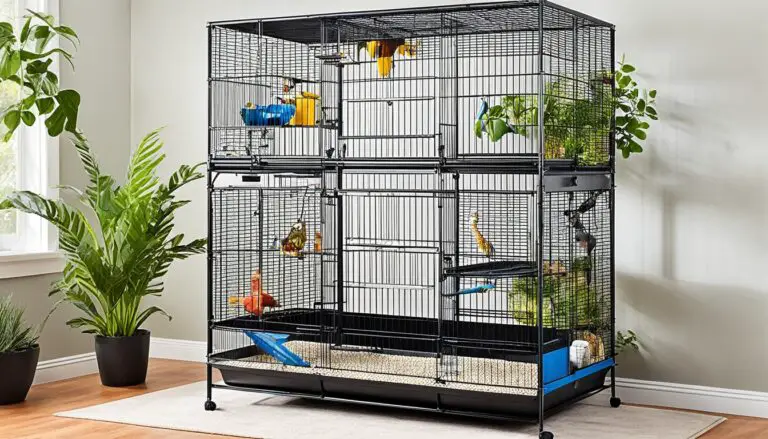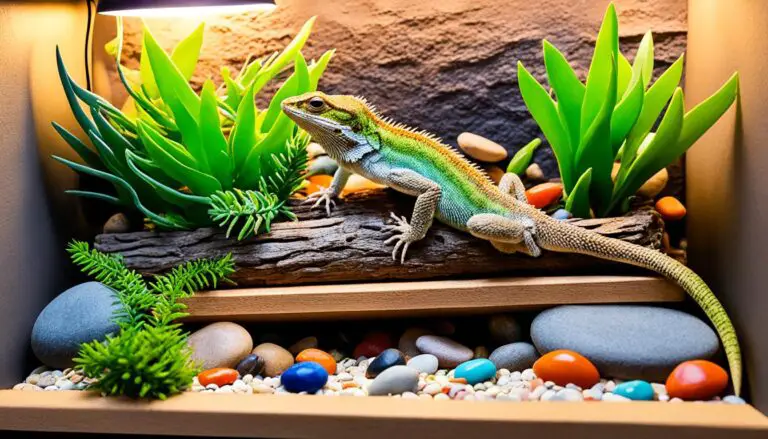Exotic Pet Vivarium Design Tips & Ideas
Looking to create a stunning habitat for your exotic pets? Discover modern terrarium setups, innovative reptile enclosure concepts, and tropical terrarium ideas in this article. We’ll provide tips and ideas for designing and creating a captivating vivarium environment for your beloved creatures.
Understanding Vivarium Ecosystems
Cultivating plants and animals together in a vivarium creates a more complex ecosystem. Managing vivariums requires a more direct approach to environmental conditions. Factors such as airflow/ventilation, water and humidity, lighting, and temperature play a crucial role in the success of a vivarium. Additionally, the choice of vivarium plants and animals should be carefully considered to create an optimal habitat for exotic pets.
One of the key aspects of vivarium design is creating a habitat that closely mimics the natural environment of the exotic pet. This involves considering the specific needs of the plants and animals that will inhabit the vivarium. For example, if you are creating a tropical vivarium for humidity-loving reptiles, such as geckos or anoles, it is important to provide adequate moisture levels and a suitable temperature range.
Proper airflow and ventilation are essential for maintaining a healthy vivarium ecosystem. This ensures that fresh air circulates throughout the enclosure and prevents the buildup of stagnant air or condensation. Adequate airflow also helps to regulate temperature and prevent the growth of mold or other harmful microorganisms.
Water and humidity levels are critical components of a vivarium ecosystem. Some plants and animals may require a high humidity environment, while others may need a drier habitat. It is important to carefully research the specific needs of the plant and animal species you plan to include in your vivarium. Monitoring and adjusting humidity levels regularly is necessary to provide the optimal conditions for their growth and well-being.
“Creating a successful vivarium is all about striking the right balance in environmental conditions. Each element, from lighting to temperature to humidity, must be tailored to the needs of the plants and animals that will inhabit the vivarium.”
Lighting is another crucial factor in vivarium design. Different plant and animal species have varying light requirements. Some may need bright, direct light, while others thrive in dimmer, more shaded conditions. Providing the right type and intensity of light is essential for the health and growth of the vivarium inhabitants. Incorporating a combination of natural sunlight, artificial UV light, and appropriate lighting fixtures can help create an ideal lighting environment.
Temperature regulation is vital for maintaining a healthy vivarium ecosystem. Exotic pets often have specific temperature requirements, and it is essential to provide a suitable range for their well-being. Using thermostats, heat mats, heat lamps, or ceramic heaters can help maintain the desired temperature in the vivarium. It is important to regularly monitor and adjust the temperature to prevent overheating or chilling.
The selection of plants and animals for your vivarium should be carefully considered. Some plant species naturally thrive in vivarium environments due to their ability to handle high humidity and low light conditions. Examples of suitable vivarium plants include ferns, bromeliads, orchids, and mosses. When choosing animals, it is crucial to consider their compatibility with the vivarium environment and other inhabitants. Reptiles, amphibians, and some insect species are commonly kept in vivariums.
Examples of Vivarium Plants
| Plant Name | Lighting Requirement | Humidity Preference |
|---|---|---|
| Bromeliad | Medium to bright indirect light | High humidity |
| Pothos | Low to medium indirect light | Medium to high humidity |
| Fern | Low to medium indirect light | Medium to high humidity |
| Moss | Low to medium indirect light | High humidity |
Creating a successful vivarium requires careful consideration of environmental factors and the needs of the vivarium plants and animals. By providing the right conditions for airflow, water and humidity, lighting, and temperature, you can create a thriving habitat for your exotic pets. Remember to regularly monitor and adjust these factors to ensure the long-term health and well-being of your vivarium ecosystem.
DIY Guide to Making a Vivarium
Creating your own vivarium can be a fun and rewarding project. With the right materials, tools, and construction techniques, you can build a custom vivarium that meets your specific needs. Whether you want to house tropical reptiles, amphibians, or even small exotic plants, this DIY guide will provide you with step-by-step instructions on how to make a vivarium.
Gather the Tools and Materials
Before you begin constructing your vivarium, it’s important to gather all the necessary tools and materials. Here are the items you’ll need:
| Tools | Materials |
|---|---|
|
|
Having these tools and materials on hand will make the construction process smoother and more efficient.
Constructing the Vivarium
Now that you have all the necessary tools and materials, it’s time to start building your vivarium. Follow these steps:
- Create a frame using the timber to provide structural support for the vivarium.
- Add plasterboard to the frame to create the walls and ceilings of the vivarium.
- Create a raised floor using appropriate materials. This will make maintenance easier and prevent moisture damage.
- Use paint and waterproofing products to ensure the longevity and functionality of the vivarium.
- Install doors, ventilation, and electrical components carefully to create a functional and aesthetically pleasing vivarium.
Expert Tip: Painting and Waterproofing
When painting and waterproofing your vivarium, use non-toxic and water-resistant products. This will ensure the safety of your pets and prevent any damage from moisture or humidity. Additionally, allow sufficient time for the paint and waterproofing to dry completely before introducing plants or animals into the vivarium.
Following these guidelines will help you create a vivarium that is both functional and visually appealing. Remember to consider the specific needs of the plants and animals you plan to house in your vivarium, as this will guide your construction and design choices.
Now that you know how to make a vivarium, you can unleash your creativity and build a unique habitat for your exotic pets or plants.
Choosing the Right Vivarium Plants
Selecting the right plants for a vivarium is crucial for creating a natural and thriving ecosystem. When it comes to vivarium plant selection, tropical plants that thrive in high humidity and moist conditions are ideal. These moisture-loving plants not only add beauty and vibrancy to the vivarium but also provide important benefits to the overall environment.
Tropical Plants for Vivariums
There are a variety of tropical plants that are well-suited for vivariums. Some popular choices include:
- Ferns: Known for their lush foliage, ferns are excellent choices for vivariums. They thrive in humid conditions and provide a natural and forest-like appearance.
- Bromeliads: These unique plants come in various shapes and sizes and add a touch of color to the vivarium. Bromeliads are known for their ability to tolerate high humidity.
- Orchids: Orchids are highly sought-after for their stunning flowers. They require a higher level of care compared to other plants, but their beauty and elegance make them worth the effort.
- Mosses: Mosses are fantastic for adding texture and depth to the vivarium. They thrive in moist environments and create a lush carpet effect.
When arranging these plants, it is essential to consider their size, growth habits, and compatibility with each other. This ensures a harmonious and visually appealing vivarium setup.
Plant Care in Vivariums
Proper plant care is essential to maintain the health and aesthetics of the vivarium. Here are some important care tips:
- Watering: Ensure that the plants receive adequate water to support their growth. However, avoid overwatering, as it can lead to root rot and other issues.
- Pruning: Regularly trim and remove any dead or decaying leaves to maintain the overall health of the plants and prevent the spread of disease.
- Fertilizing: Use a slow-release fertilizer specifically formulated for vivarium plants. Follow the manufacturer’s instructions for proper application.
Researching the specific needs of each plant species is essential to ensure their suitability for a vivarium environment. By providing the right conditions and proper care, you can create a lush and thriving plant ecosystem that enhances the overall beauty and functionality of your vivarium.
| Plant Name | Lighting Requirements | Moisture Requirements | Preferred Temperature Range |
|---|---|---|---|
| Ferns | Indirect or filtered bright light | Consistently moist soil | 60-75°F (15-24°C) |
| Bromeliads | Bright, indirect light | Moderately moist soil | 70-85°F (21-29°C) |
| Orchids | Indirect, bright light | Moist but not waterlogged | 65-75°F (18-24°C) |
| Mosses | Low to moderate light | Consistently moist | 60-80°F (15-27°C) |
Image:

Choosing the Right Vivarium Animals
When it comes to selecting animals for your vivarium, it’s crucial to consider species that are compatible with the environment and other inhabitants. While reptiles and amphibians are popular choices, it’s important to take into account their specific needs and behaviors. Factors such as temperature, humidity, and diet play a significant role when choosing vivarium animals.
Creating the perfect habitat for your vivarium animals involves providing suitable hiding spots, climbing structures, and appropriate substrate for their comfort and well-being. Additionally, incorporating innovative reptile enclosure concepts and amphibian habitat design can enhance the overall appeal of your vivarium.
Exotic Animal Enclosure Tips
“Choosing the right vivarium animals is not limited to their species, but also the conditions you can provide for them.”
– Dr. Olivia Anderson, Exotic Pet Specialist
By considering the unique needs of each species, you can ensure a harmonious and thriving vivarium ecosystem. Here are some essential tips for choosing the right vivarium animals:
- Research the temperature and humidity requirements of different reptiles and amphibians to ensure they align with your vivarium’s conditions.
- Choose species that are compatible with each other, considering their behavior and size.
- Consider the dietary needs of the animals and ensure you can provide proper nutrition.
- Provide adequate space and appropriate hiding spots for the animals to feel secure.
- Consider the availability of veterinary care for the chosen species.
Reptile Enclosure Innovation and Amphibian Habitat Design
In recent years, there have been significant advancements in reptile enclosure innovation and amphibian habitat design. These advancements have facilitated the creation of more naturalistic and functional vivariums.
Reptile enclosure innovation involves incorporating features such as temperature-controlled zones, automated humidity systems, and customizable lighting. These advancements allow for more precise control over the vivarium’s environment, ensuring optimal conditions for the reptiles.
Amphibian habitat design focuses on mimicking the natural habitats of amphibians, providing them with suitable areas for both land and water activities. The inclusion of water features, such as streams and ponds, enhances the vivarium’s aesthetics and creates a more authentic environment for amphibians.
Choosing the Right Vivarium Animals Table
| Species | Temperature Range | Humidity Requirements | Diet |
|---|---|---|---|
| Leopard Gecko | 88-92°F (31-33°C) | 30-40% | Insects (mealworms, crickets) |
| Corn Snake | 75-85°F (24-29°C) | 40-50% | Small rodents (mice, rats) |
| Red-eyed Tree Frog | 75-85°F (24-29°C) | 70-90% | Insects (crickets, flies) |
Choosing the right vivarium animals requires careful consideration of their individual needs and compatibility with the vivarium’s environment. By following these tips and incorporating reptile enclosure innovation and amphibian habitat design, you can create a vibrant and thriving vivarium ecosystem for your exotic pets.
Maintaining a Thriving Vivarium Ecosystem
Keeping a vivarium ecosystem thriving involves careful maintenance and management to ensure optimal conditions for the plants and animals. Regular monitoring and adjustment of environmental factors such as lighting, temperature, humidity, and airflow are essential for the well-being of the vivarium inhabitants. Additionally, proper cleaning and pruning of plants, as well as regular health checks on the animals, are necessary to maintain a balanced and sustainable ecosystem.
In order to maintain a thriving vivarium ecosystem, it is important to pay attention to the following key aspects:
1. Vivarium Lighting
Proper lighting is crucial for the growth and vitality of the plants in the vivarium. Different species of plants may have varying light requirements, so it is important to research and provide the appropriate lighting conditions. This can be achieved through the use of artificial lighting fixtures that mimic natural sunlight or by positioning the vivarium near a window with sufficient sunlight exposure. Regularly checking and adjusting the light intensity and duration can help promote healthy plant growth.
2. Temperature Control
Maintaining the correct temperature range is vital for the well-being of both the plants and animals in the vivarium. Monitoring the temperature using a reliable thermometer and adjusting it accordingly helps create a comfortable environment. Some species may require specific temperature gradients within the vivarium, so it is important to provide localized heating or cooling sources to meet their needs. Regular temperature checks and adjustments ensure a stable and suitable habitat for the vivarium inhabitants.
3. Humidity Regulation
Many exotic plants and animals thrive in high humidity environments, so proper humidity regulation is essential for their well-being. Monitoring and adjusting the humidity levels using a hygrometer and employing techniques such as misting, water features, or the use of humidity control devices help maintain the desired humidity range. Regularly checking and adjusting the humidity levels ensure that the vivarium ecosystem remains conducive for the plants and animals.
4. Airflow and Ventilation
Good airflow and ventilation are necessary to prevent the buildup of stagnant air and to control excess moisture. Ensuring adequate ventilation helps maintain proper air quality and reduces the risk of mold or fungal growth. Installing vents, fans, or natural air circulation methods, such as strategically placed openings or mesh coverings, promotes efficient airflow and ventilation within the vivarium.
To summarize, proper vivarium maintenance is essential for creating and sustaining a thriving ecosystem. Regular monitoring and adjustment of lighting, temperature, humidity, and airflow, along with regular cleaning and plant pruning, contribute to the overall well-being of the plants and animals in the vivarium. By taking these measures, you can create a balanced and sustainable vivarium ecosystem that provides a healthy and captivating habitat for your exotic pets.

Personalize Your Vivarium
Personalizing your vivarium adds a unique touch and enhances the aesthetics of the enclosure. Whether you have a reptile, amphibian, or any other exotic pet, creating a personalized habitat not only provides a visually appealing display but also mimics their natural environment, promoting their well-being.
Using Natural Elements
One way to personalize your vivarium is by incorporating natural elements such as rocks, branches, and logs. These elements not only create a more naturalistic environment but also provide hiding spots and climbing structures for your pets. Just be sure to choose items that are safe and non-toxic for your animals.
Creative Decor Items
Another way to add personality to your vivarium is by using creative decor items. Consider adding artificial plants that mimic the lush foliage found in your pet’s natural habitat. Background prints with jungle or desert scenes can also enhance the overall visual appeal of the enclosure.
“Adding custom-built hiding spots can provide your pets with a sense of security and privacy, ensuring their mental well-being.”
| Unique Animal Habitat | Reptile Tank Decor | Custom Reptile Enclosure | Creative Reptile Tank Setups |
|---|---|---|---|
| Incorporate natural elements | Add artificial plants | Create custom hiding spots | Utilize background prints |
| Provide hiding spots and climbing structures | Enhance visual appeal | Promote a sense of security | Add depth and dimension |
| Mimic natural environment | Imitate lush foliage | Ensure well-being of pets | Create a captivating display |
When personalizing your vivarium, it’s important to consider the needs of your animals. Ensure that any decor items or structures you add do not pose any risk of injury or harm. Your pet’s safety and well-being should always be a top priority.
By personalizing your vivarium, you can create a visually stunning and functional enclosure that both you and your exotic pets will enjoy. Let your creativity shine as you design a unique habitat that reflects the beauty of nature and provides a comfortable home for your beloved pets.
Conclusion
Designing and creating an exotic pet vivarium is a rewarding and fulfilling experience. By understanding the key factors for vivarium ecosystems, making a vivarium using proper materials and tools, selecting suitable plants and animals, and maintaining the vivarium ecosystem, you can create a unique and thriving habitat for your exotic pets.
Personalizing the vivarium adds a personal touch and enhances the overall appeal of the enclosure. By adding natural elements like rocks, branches, and logs, you can create a naturalistic environment that mimics the exotic habitats of your pets. Additionally, using creative decor items such as artificial plants, background prints, and custom-built hiding spots can make the vivarium more visually appealing. Remember to consider the needs of the animals when adding decor items to ensure their safety and well-being.
With proper care and attention, your exotic pet vivarium can become a captivating centerpiece in your home. Regular maintenance, which includes monitoring and adjusting environmental factors, cleaning, and pruning, is essential for the well-being of the vivarium inhabitants. By creating a balanced and sustainable vivarium ecosystem, you can provide a thriving habitat that will not only showcase the beauty of your exotic pets but also create a tranquil and captivating environment for you to enjoy.
FAQ
What is a vivarium?
What factors are important for managing a vivarium?
What tools are needed to build a vivarium?
What plants are suitable for a vivarium?
What should I consider when choosing vivarium animals?
How do I maintain a thriving vivarium ecosystem?
How can I personalize my vivarium?
Source Links
- https://terrariumtribe.com/vivariums-guide/
- https://www.dendroboard.com/threads/building-vivariums-for-a-living.81786/
- https://www.instructables.com/Vivarium-for-a-Reptile/
Peter Stones is the founder of Exotic Pets Place, the leading online resource for exotic pet care information.
With over 10 years of hands-on exotic pet ownership experience, he is deeply passionate about sharing his expertise to help others properly care for their unusual pets.
When he's not writing extensively researched articles or connecting with fellow exotic pet enthusiasts worldwide, you can find Peter at home tending to his own beloved menagerie of exotic animals.

